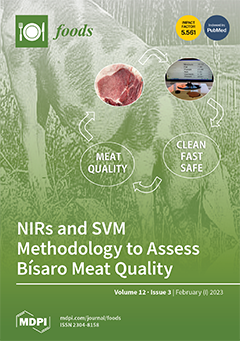Scorias spongiosa, a type of edible fungus, is beneficial for intestinal health. However, the mechanisms by which polysaccharides derived from
S.
spongiosa contribute to the integrity of the intestinal barrier have been little investigated. In the present study, 40 C57BL/6J mice
[...] Read more.
Scorias spongiosa, a type of edible fungus, is beneficial for intestinal health. However, the mechanisms by which polysaccharides derived from
S.
spongiosa contribute to the integrity of the intestinal barrier have been little investigated. In the present study, 40 C57BL/6J mice were assigned into five groups: (1) Normal; (2) Dextran sulfate sodium (DSS)Administration; (3) DSS + Uncapped polysaccharides; (4) DSS + Low microcapsules; (5) DSS + High microcapsules. After one week of administration of
S. spongiosa polysaccharides, all mice, excluding the Normal group, had free access to the drinking water of 3.5% DSS for seven days. Serum and feces were then taken for analysis. Scanning electron microscopy analysis indicated the structure of the micro-capped polysaccharides with curcumin was completed with a rough surface, which differs from the uncapped polysaccharides. Noticeably,
S. spongiosa polysaccharides enhanced intestinal barrier integrity as evidenced by increasing the protein levels of Claudin-1, ZO-1 and ZO-2. Low-capped polysaccharides mitigated the DSS-induced oxidative stress by increasing catalase (CAT) concentration and decreasing malondialdehyde (MDA) and myeloperoxidase (MPO) concentrations. Besides, DSS treatment caused a disturbance of inflammation and the contents of IL-1β, IL-6, TNF-α and CRP were downregulated and the contents of IL-4, IL-10 and IFN-γ were upregulated by
S. spongiosa polysaccharides. Research on the potential mechanisms indicated that
S. spongiosa polysaccharides inhibited the DSS-triggered activation of NF-κB signaling. Moreover, the JAK/STAT1 and MAPK pathways were suppressed by
S. spongiosa polysaccharides in DSS-challenged mice, with Lcap showing the strongest efficacy. 16S rDNA amplicon sequencing revealed that the richness and diversity of the microbial community were reshaped by
S. spongiosa polysaccharide ingestion. Therefore, our study substantiated that
S. spongiosa polysaccharides exhibited protective effects against colitis mice by reshaping the intestinal microbiome and maintaining the balance of intestinal barrier integrity, antioxidant capacity and colonic inflammation through regulation of the NF-κB–STAT1–MAPK axis.
Full article






